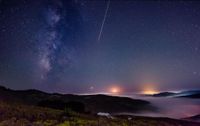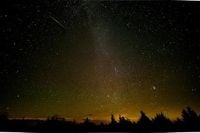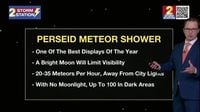Every August, stargazers across the Northern Hemisphere look forward to a celestial tradition: the Perseid meteor shower. This year, the much-anticipated event will reach its peak on the night of August 12 to August 13, 2025. But unlike some years when the heavens offer a dark, star-studded canvas, skywatchers in 2025 will face a formidable rival—the nearly full Sturgeon Moon, shining at about 80 to 84 percent illumination and rising before midnight. According to The Economic Times, this bright moon phase is expected to wash out many of the fainter meteors, making for a more subdued show than usual.
The Perseids, named for the constellation Perseus from which they appear to radiate, are among the most reliable and dazzling meteor showers. Under ideal, moonless conditions, observers can expect to see between 60 and 100 meteors per hour, with some years producing even more. As The New York Times reports, the Perseids are famous for their long, colorful streaks and even blue fireballs—meteors that burn especially bright and linger in the sky for several seconds. These natural fireworks are caused by Earth plowing through the debris trail left by Comet Swift-Tuttle, a massive comet roughly 16 miles (26 kilometers) wide that last swung through the inner solar system in 1992 and won’t return until 2125.
But the spectacle in 2025 will be tempered by the moon’s glow. The full Sturgeon Moon occurs on August 9, and by the peak night of August 12–13, it remains nearly full, rising around the same time as darkness falls. For instance, in New York on August 9, sunset is at 8:27 p.m. EDT, the moon rises at 10:01 p.m., and astronomical twilight begins at 10:28 p.m. That leaves little time for true darkness before moonlight floods the sky. As a result, the American Meteor Society estimates that only the brightest meteors—perhaps 10 to 20 per hour—will be visible in most locations, a far cry from the shower’s usual bounty.
Still, the Perseids have a way of putting on a show, even when conditions aren’t perfect. As The Press Democrat notes, the shower is active from July 17 to August 24, with the best viewing between 2:00 a.m. and 4:00 a.m. local time, when the radiant in Perseus is highest in the sky and meteor rates peak. While the moon’s glare will make faint meteors tough to spot, the Perseids’ signature fireballs can still cut through the brightness, rewarding patient observers with sudden, brilliant flashes.
To maximize your chances of seeing the show, experts recommend a few tried-and-true tips. First, head for the darkest location you can find—think rural areas, national parks, or mountaintops far from city lights. States like Utah, Arizona, Colorado, and California are perennial favorites for meteor watching, and in Sonoma County, California, spots such as Bodega Head, Lake Sonoma, Meyers Grade Road, Portuguese Beach, and Sugarloaf Ridge State Park offer excellent vantage points. Arrive at your chosen site at least an hour before sunrise, and give your eyes 20 to 30 minutes to adjust to the darkness. Avoid using bright electronic devices, as even a quick glance at your phone can ruin your night vision.
Michelle Nichols, director of public observing at Chicago’s Adler Planetarium, suggests leaving telescopes and binoculars at home. “You just need your eyes and, ideally, a dark sky,” she told The New York Times. Because meteors can streak across huge swathes of the sky, using magnifying equipment can actually limit what you see. Instead, bring a reclining chair or sleeping bag, face northeast (with your back to the moon, which will be low in the southern sky), and settle in for the show. Dress warmly—even in August, the night air can get chilly—and consider packing snacks and a hot drink to make the wait more comfortable.
For those hoping to capture the Perseids on camera, the advice is equally straightforward. Use a DSLR or mirrorless camera mounted on a tripod, with a wide-angle lens (14–24 mm), a fast aperture (f/2.8 or faster), ISO 800–1600, and exposure times of 20–30 seconds. Focus on a bright star, use a remote shutter or intervalometer, and aim your camera 30–40 degrees away from the radiant to catch long meteor trails. Most importantly, try to keep the moon out of your frame to avoid its overpowering glare.
The Perseids aren’t just a modern spectacle—they’re steeped in history. Observations date back to at least 100 BC, making them one of the oldest recorded meteor showers. Their parent, Comet Swift-Tuttle, has an orbit of 133 years, leaving behind a wide debris field that Earth crosses every summer. As our planet plows through this cosmic dust, particles as tiny as grains of sand burn up in the atmosphere, creating the streaks and fireballs we see as meteors. According to The Economic Times, "As Earth passes through the dust trail left by the comet, these particles burn up in the atmosphere, producing meteors."
Though the moon will make 2025’s show less dramatic than some years, experts say it’s still worth venturing out—especially if you’ve never witnessed a meteor shower before. The Perseids are one of the few astronomical events that require no special equipment or tickets, just a willingness to look up and marvel. And if clouds spoil the view on the peak night, don’t despair—the shower remains active for several days before and after, with meteor rates gradually declining as the moon rises later each night and the Earth moves out of the densest part of the debris stream.
Ultimately, the Perseid meteor shower is a reminder of our connection to the wider cosmos, a fleeting but spectacular display that has inspired awe for centuries. Whether you see a handful of bright fireballs or dozens of streaks, the experience of watching the Perseids—blanket, cocoa, and all—is one that stays with you long after the last meteor fades. So mark your calendars, find a dark spot, and get ready for one of nature’s most enchanting shows. The sky, as ever, is ready to dazzle.


